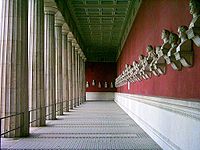Ruhmeshalle (Munich)
- View a machine-translated version of the German article.
- Machine translation, like DeepL or Google Translate, is a useful starting point for translations, but translators must revise errors as necessary and confirm that the translation is accurate, rather than simply copy-pasting machine-translated text into the English Wikipedia.
- Consider adding a topic to this template: there are already 9,156 articles in the main category, and specifying
|topic=will aid in categorization. - Do not translate text that appears unreliable or low-quality. If possible, verify the text with references provided in the foreign-language article.
- You must provide copyright attribution in the edit summary accompanying your translation by providing an interlanguage link to the source of your translation. A model attribution edit summary is
Content in this edit is translated from the existing German Wikipedia article at [[:de:Ruhmeshalle (München)]]; see its history for attribution. - You may also add the template
{{Translated|de|Ruhmeshalle (München)}}to the talk page. - For more guidance, see Wikipedia:Translation.
The Ruhmeshalle (literally "hall of fame") is a Doric colonnade with a main range and two wings, designed by Leo von Klenze for Ludwig I of Bavaria. Built in 1853, it is situated on an ancient ledge above the Theresienwiese in Munich and was built as part of a complex which also includes the Bavariapark and the Bavaria statue.[1] It is built of Kelheim limestone and is 68 metres long and 32 metres deep.
With the construction and exhibition of busts of important people from Bavaria, including the Palatinate, Franconia and Swabia, King Ludwig intended to create a hall of fame that honors laudable and distinguished people of his kingdom, as he did also in the Walhalla memorial for all of Germany.
In 1944, a bombing raid caused several busts' destruction.
-
 The Ruhmeshalle with the statue of Bavaria by Ludwig Schwanthaler
The Ruhmeshalle with the statue of Bavaria by Ludwig Schwanthaler -
 Aerial photograph: Ruhmeshalle and Bavaria monument (2009)
Aerial photograph: Ruhmeshalle and Bavaria monument (2009) - Interior of the Ruhmeshalle
See also
- Befreiungshalle (Hall of Liberation, Kelheim, Germany)
- Heldenberg Memorial (Austria)
- Hermannsdenkmal (Hermann monument, Teutoburg Forest, Germany)
References
- ^ Colwell, Dan (2001). Munich. Hunter Publishing, Inc. p. 44.
External links

- Bayerische Schlösserverwaltung on the Ruhmeshalle
- Panorama of the Ruhmeshalle and the Bavaria statue
48°07′51″N 11°32′44″E / 48.130778°N 11.545667°E / 48.130778; 11.545667














